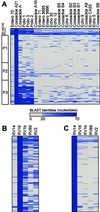Microarray-based detection and genotyping of viral pathogens
- PMID: 12429852
- PMCID: PMC137777
- DOI: 10.1073/pnas.242579699
Microarray-based detection and genotyping of viral pathogens
Abstract
The detection of viral pathogens is of critical importance in biology, medicine, and agriculture. Unfortunately, existing techniques to screen for a broad spectrum of viruses suffer from severe limitations. To facilitate the comprehensive and unbiased analysis of viral prevalence in a given biological setting, we have developed a genomic strategy for highly parallel viral screening. The cornerstone of this approach is a long oligonucleotide (70-mer) DNA microarray capable of simultaneously detecting hundreds of viruses. Using virally infected cell cultures, we were able to efficiently detect and identify many diverse viruses. Related viral serotypes could be distinguished by the unique pattern of hybridization generated by each virus. Furthermore, by selecting microarray elements derived from highly conserved regions within viral families, individual viruses that were not explicitly represented on the microarray were still detected, raising the possibility that this approach could be used for virus discovery. Finally, by using a random PCR amplification strategy in conjunction with the microarray, we were able to detect multiple viruses in human respiratory specimens without the use of sequence-specific or degenerate primers. This method is versatile and greatly expands the spectrum of detectable viruses in a single assay while simultaneously providing the capability to discriminate among viral subtypes.
Figures




References
-
- Storch G. A., (2000) Essentials of Diagnostic Virology (Churchill Livingstone, New York).
Publication types
MeSH terms
Substances
Grants and funding
LinkOut - more resources
Full Text Sources
Other Literature Sources
Miscellaneous

